Uniaxial Compressive Stress–Strain Model of Jujube Nucleus Concrete following Exposure to Elevated Temperatures
Abstract
:1. Introduction
2. Materials and Methods
2.1. Materials
2.1.1. Natural Aggregate, Cement, and Water
2.1.2. Jujube Nucleus
2.2. Mixture Design and Specimen Preparation
2.2.1. Mixture Proportions of Concrete
2.2.2. Preparation of Specimens
2.3. Testing Procedure
2.3.1. Mechanical Properties Test under Room Temperature
2.3.2. Heating Regime
3. Results and Discussions
3.1. Failure Pattern
3.2. Uniaxial Compressive Stress–strain Curves
3.2.1. Effects of the Elevated Temperature on Stress Strain Curves for JNC
3.2.2. Effects of the Replacement Ratio on Stress–Strain Curves for JNC
3.3. Stress Strain Characteristic
3.3.1. Peak Stress of JNC
3.3.2. Elastic Modules of JNC
3.3.3. Peak Strain of JNC
4. Constitutive Model of JNC
4.1. Suggested Stress–Strain Model for JNC
4.2. Analysis of Model Parameters
4.2.1. Ascending Branch Parameter A
4.2.2. Ascending Branch Parameter B
4.2.3. Descending Branch Parameters αc
4.3. Model Validation
5. Conclusions and Next Steps in the Research
- (1)
- Different from ordinary concrete, the increase in the JN replacement ratio and the elevated temperature would result in the growing number and width of the vertical and diagonal cracks for JNC whilst the linear proportion in the ascending branch and the descending slope increased gradually for the stress–strain curves of JNC, probably due to the low stiffness and high porosity of the jujube nucleus.
- (2)
- The rise in the JN replacement ratio and elevated temperature would decrease the peak stress and elastic modulus but would cause a rapid increase in the peak strain in the stress–strain curves of JNC, which is ascribed possibly to the fact that sucrose molecules can hinder the growth of calcium silicate hydrate and calcium hydroxide to a larger content.
- (3)
- When the JN replacement ratio reaches 25%, the reduction in the peak stress and elastic modulus is 26.36% and 11.27%, respectively, whilst the reduction in the peak stress and elastic modulus of JNC under 100% replacement ratio is 96.60% and 59.48%, respectively. The peak strain of JNC under 25% and 100% replacement ratio increases by 15.93% and 67.24%, respectively.
- (4)
- When the elevated temperature is up to 100 °C, the peak stress and elastic modulus for JNC under 25% replacement ratio decrease by approximately 8.00% and 4.16%, respectively, whilst the reduction increases to 33.00% and 20.52%, respectively, under 400 °C heating. The peak strain of JNC with 25% replacement ratio increases from 2.53% under 100 °C to 19.70% under 400 °C.
- (5)
- A material constitutive model is developed based on the test results for describing the stress–strain relationship of JNC under the effect of the JN replacement ratio and the elevated temperature. The predicted stress–strain curves using the model can match well with the tested stress–strain curves under the different JN replacement ratios and elevated temperatures.
Author Contributions
Funding
Institutional Review Board Statement
Informed Consent Statement
Data Availability Statement
Acknowledgments
Conflicts of Interest
References
- Tam, V.W.Y.; Soomro, M.; Evangelista, A.C.J. A review of recycled aggregate in concrete applications (2000–2017). Constr. Build. Mater. 2018, 172, 272–292. [Google Scholar] [CrossRef]
- Xiao, J.; Li, W.; Fan, Y.; Huang, X. An overview of study on recycled aggregate concrete in China (1996–2011). Constr. Build. Mater. 2012, 31, 364–383. [Google Scholar] [CrossRef]
- Gao, S.; Zhao, G.; Guo, L.; Zhou, L.; Yuan, K. Utilization of coal gangue as coarse aggregates in structural concrete. Constr. Build. Mater. 2021, 268, 121212. [Google Scholar] [CrossRef]
- Gao, S.; Zhao, G.; Guo, L.; Zhou, L.; Cui, X.; Yang, H. Mechanical properties of circular thin-tubed molybdenum tailing concrete stubs. Constr. Build. Mater. 2021, 268, 121215. [Google Scholar] [CrossRef]
- Tam, V.W.Y.; Soomro, M.; Evangelista, A.C.J. Quality improvement of recycled concrete aggregate by removal of residual mortar: A comprehensive review of approaches adopted. Constr. Build. Mater. 2021, 288, 123066. [Google Scholar] [CrossRef]
- Gao, S.; Cui, X.; Kang, S.; Ding, Y. Sustainable applications for utilizing molybdenum tailings in concrete. J. Clean. Prod. 2020, 266, 122020. [Google Scholar] [CrossRef]
- Wang, W.; Wei, W.; Gao, S.; Chen, G.; Yuan, J.; Li, Y. Agricultural and Aquaculture Wastes as Concrete Components: A Review. Front. Mater. 2021, 8, 762568. [Google Scholar] [CrossRef]
- Liu, C.; Hai, N.; Zhang, Y. The content variation of phytochemicals in different parts of Chinese jujube from different Cultivars. Mod. Food Sci. Technol. 2014, 30, 258–261+205. (In Chinese) [Google Scholar]
- Xie, Y.; Chu, H.H.; Li, G.Y.; Tao, P.; Lin, X. Preparation and uranium adsorption property of activated carbon from jujube nucleus. J. Southwest Univ. Sci. Technol. 2021, 36, 1–8. (In Chinese) [Google Scholar]
- Alam Khan, T.; Nouman, M.; Dua, D.; Khan, S.A.; Alharthi, S.S. Adsorptive scavenging of cationic dyes from aquatic phase by H3PO4 activated indian jujube (ziziphus mauritiana) seeds based activated carbon: Isotherm, kinetics, and thermodynamic study. J. Saudi Chem. Soc. 2022, 26, 101417. [Google Scholar] [CrossRef]
- Lu, W.; Cai, H.; Yu, W.; Xu, H.; Han, X. Mechanical properties of jujube pit/linear low density polyethylene composites. Acta Mater. Compos. Sin. 2021, 38, 1775–1783. (In Chinese) [Google Scholar]
- Ganiron, T.U., Jr. Sustainable management of waste coconut shells as aggregates in concrete mixture. J. Eng. Sci. Technol. Rev. 2013, 6, 7–14. [Google Scholar] [CrossRef]
- Gunaskearan, K.; Kumar, P.S.; Lakshmipathy, M. Mechanical and bond properties of coconut shell concrete. Constr. Build. Mater. 2011, 25, 92–98. [Google Scholar] [CrossRef]
- Alengaram, U.J.; Munit, B.A.A.; Jumaat, M.Z.B. Utilization of oil palm kernel shell as lightweight aggregate in concrete—A review. Constr. Build. Mater. 2013, 38, 161–172. [Google Scholar] [CrossRef]
- Khan, M.M.H.; Guong, W.L.; Deepak, T.J.; Nair, S. Use of oil palm shell as replacement of coarse aggregate for investigating properties of concrete. Int. J. Appl. Eng. Res. 2016, 11, 2379–2383. [Google Scholar]
- Muthusamy, K.; Nordin, N.; Vesuvapateran, G.; Ali, M.; Mohd Annual, N.A.; Harun, H.; Ullap, H. Exploratory study of rubber seed shell as partial coarse aggregate replacement in concrete. Res. J. Appl. Sci. Eng. Technol. 2014, 7, 1199–1202. [Google Scholar] [CrossRef]
- Memon, S.A.; Javed, U.; Khushnood, R.A. Eco-friendly utilization of corncob ash as partial replacement of sand in concrete. Constr. Build. Mater. 2019, 195, 165–177. [Google Scholar] [CrossRef]
- Netinger, I.; Kesegic, I.; Guljas, I. The effect of high temperatures on the mechanical properties of concrete made with different types of aggregates. Fire Saf. J. 2011, 46, 425–430. [Google Scholar] [CrossRef]
- Abdulhameed, H.; Mansi, A.; Mohammed, A.; Abdulhameed, A.; Hanoon, A. Study the use of Nano-limestone and Egg-shell Ash in Eco-friendly SCC: An Experimental and Statistical Evaluation Based on Computer Programming. In Proceedings of the 2021 14th International Conference on Developments in eSystems Engineering (DeSE), Sharjah, United Arab Emirates, 7–10 December 2021; pp. 509–514. [Google Scholar]
- Mo, K.H.; Alengaram, U.J.; Jumaat, M.Z.; Liu, M.J.Y.; Lim, J. Assessing some durability properties of sustainable lightweight oil palm shell concrete incorporating slag and manufactured sand. J. Clean. Prod. 2016, 112, 763–770. [Google Scholar] [CrossRef]
- Gunasekaran, K.; Annadurai, R.; Kumar, P.S. A study on some durability properties of coconut shell aggregate concrete. Mater. Struct. 2015, 48, 1253–1264. [Google Scholar] [CrossRef]
- JGJ 52-2006; Standard for Technical Requirements and Test Method of Sand and Crushed Stone (or Gravel) for Ordinary Concrete. Ministry of Construction of the People’s Republic of China: Beijing, China, 2007.
- Zhang, Q.; Wang, Z.; Shan, G.; Zhu, E.; Ly, F.; Zhou, G. Research progress in chemical constituents of Zizyphus jujuba. Acta Agric. Jiangxi 2013, 25, 25–29. (In Chinese) [Google Scholar]
- Hanehara, S.; Yamada, K. Interaction between cement and chemical admixture from the point of cement hydration, absorption behaviour of admixture, and paste rheology. Cem. Concr. Res. 1999, 29, 1159–1165. [Google Scholar] [CrossRef]
- Long, W.; Wang, Y. Effect of pine needle fiber reinforcement on the mechanical properties of concrete. Constr. Build. Mater. 2021, 278, 122333. [Google Scholar] [CrossRef]
- GB/T 17431.2-2010; Lightweight Aggregates and Its Test Methods—Part 2: Test Methods for Lightweight Aggregates. General Administration of Quality Supervision, Inspection and Quarantine of the People’s Republic of China: Beijing, China, 2011.
- Cui, Z.; Li, J. Effect of coarse aggregate with different water absorption on strength and drying shrinkage of concrete. Bull. Chin. Ceram. Soc. 2016, 36, 2396–2399. (In Chinese) [Google Scholar]
- JGJ 55-2011; Specification for Mix Proportion Design of Ordinary Concrete. Ministry of Housing and Urban-Rural Development of the People’s Republic of China: Beijing, China, 2011.
- Mohamedbhai, G.T.G. Effect of exposure time and rates of heating and cooling on residual strength of heated concrete. Mag. Concr. Res. 1986, 38, 151–158+66. [Google Scholar] [CrossRef]
- Liu, J.C.; Tan, K.H.; Yao, Y. A new perspective on nature of fire-induced spalling in concrete. Constr. Build. Mater. 2018, 184, 581–590. [Google Scholar] [CrossRef]
- Fan, L.D.; Li, P.T.; Yu, Y.Q.; Zhang, Z.J. Research progress on property, constitutive relation and failure mechanism of lightweight aggregate concrete. Concrete 2017, 11, 44–49. (In Chinese) [Google Scholar]
- Shen, W.; Zhou, M. Influence Mechanism of Sucrose on Hydration Process of Portland Cement. J. Build. Mater. 2007, 10, 566–572. (In Chinese) [Google Scholar]
- Tanyildizi, H.; Coskun, A. The effect of high temperature on compressive strength and splitting tensile strength of structural lightweight concrete containing fly ash. Constr. Build. Mater. 2008, 22, 2269–2275. [Google Scholar] [CrossRef]
- GB/T 50010-2010; Code for Design of Concrete Structures. Ministry of Housing and Urban-Rural Development of the People’s Republic of China: Beijing, China, 2010.
- Yu, Z.W.; Ding, F.X. Unified calculation method of compressive mechanical properties of concrete. J. Build. Struct. 2003, 24, 41–46. (In Chinese) [Google Scholar]
- Xi, Y.L. Material and structural properties of coal gangue and coal gangue concrete. Ind. Constr. 1983, 3, 30–40. (In Chinese) [Google Scholar]
- Ding, F.X.; Ying, X.W.; Yu, Z.W. Unified calculation method of uniaxial mechanical properties of lightweight aggregate concrete. J. Cent. South Univ. 2010, 41, 1973–1979. (In Chinese) [Google Scholar]
- Wang, Z.Y.; Ding, J.T.; Guo, Y.S. Stress-strain curves of structural lightweight aggregate concrete. Concrete 2005, 3, 39–41+66. (In Chinese) [Google Scholar]
- Al-Kharabsheh, B.N.; Arbili, M.M.; Majdi, A.; Majdi, A.; Alogla, S.M.; Hakamy, A.; Ahmad, J.; Deifalla, A.F. Basalt Fiber Reinforced Concrete: A Compressive Review on Durability Aspects. Materials 2023, 16, 429. [Google Scholar] [CrossRef] [PubMed]
- Abdulhameed, A.A.; Al-Zuhairi, A.H.; Al Zaidee, S.R.; Hanoon, A.N.; Al Zand, A.W.; Hason, M.M.; Abdulhameed, H.A. The Behavior of Hybrid Fiber-Reinforced Concrete Elements: A New Stress-Strain Model Using an Evolutionary Approach. Appl. Sci. 2022, 12, 2245. [Google Scholar] [CrossRef]



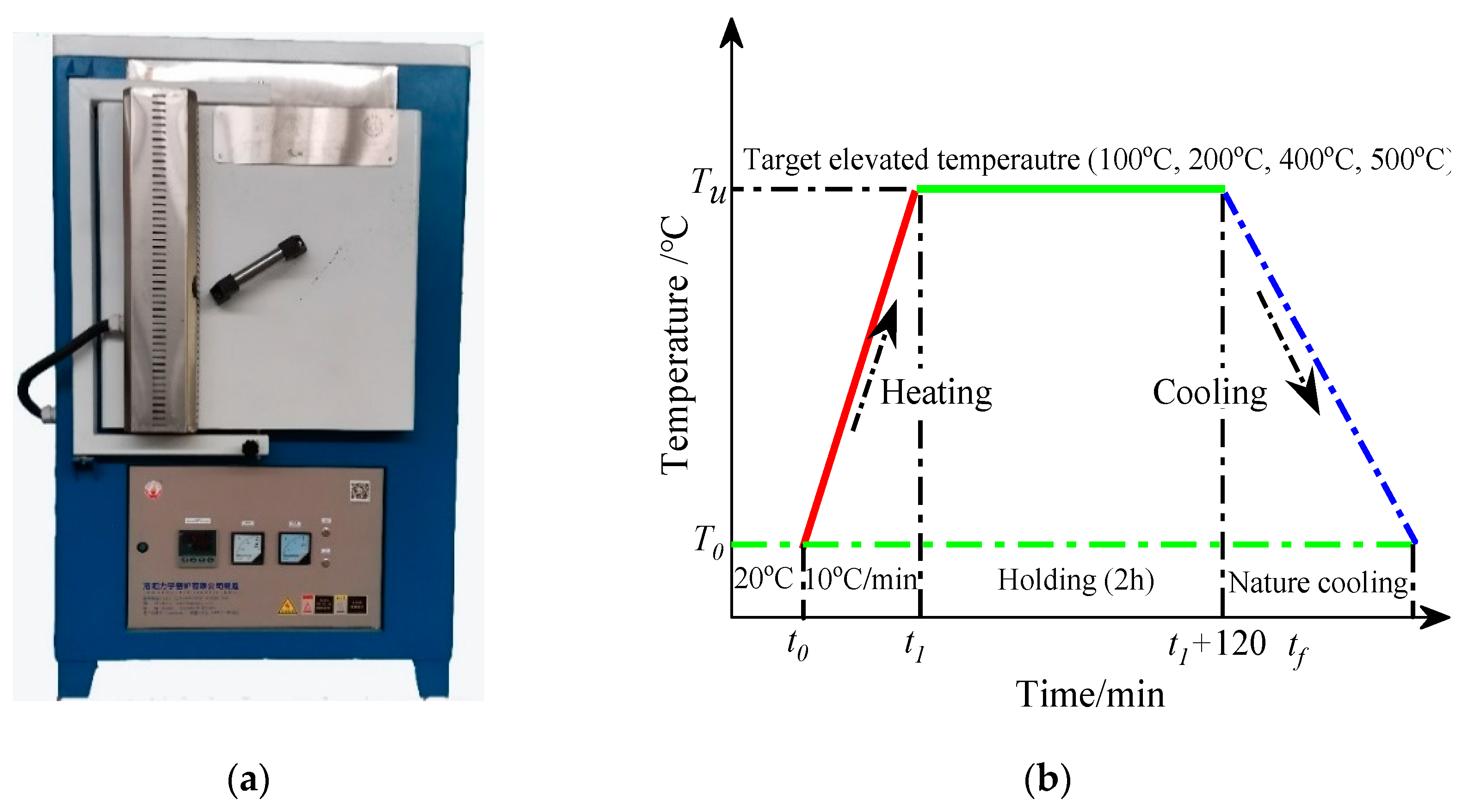
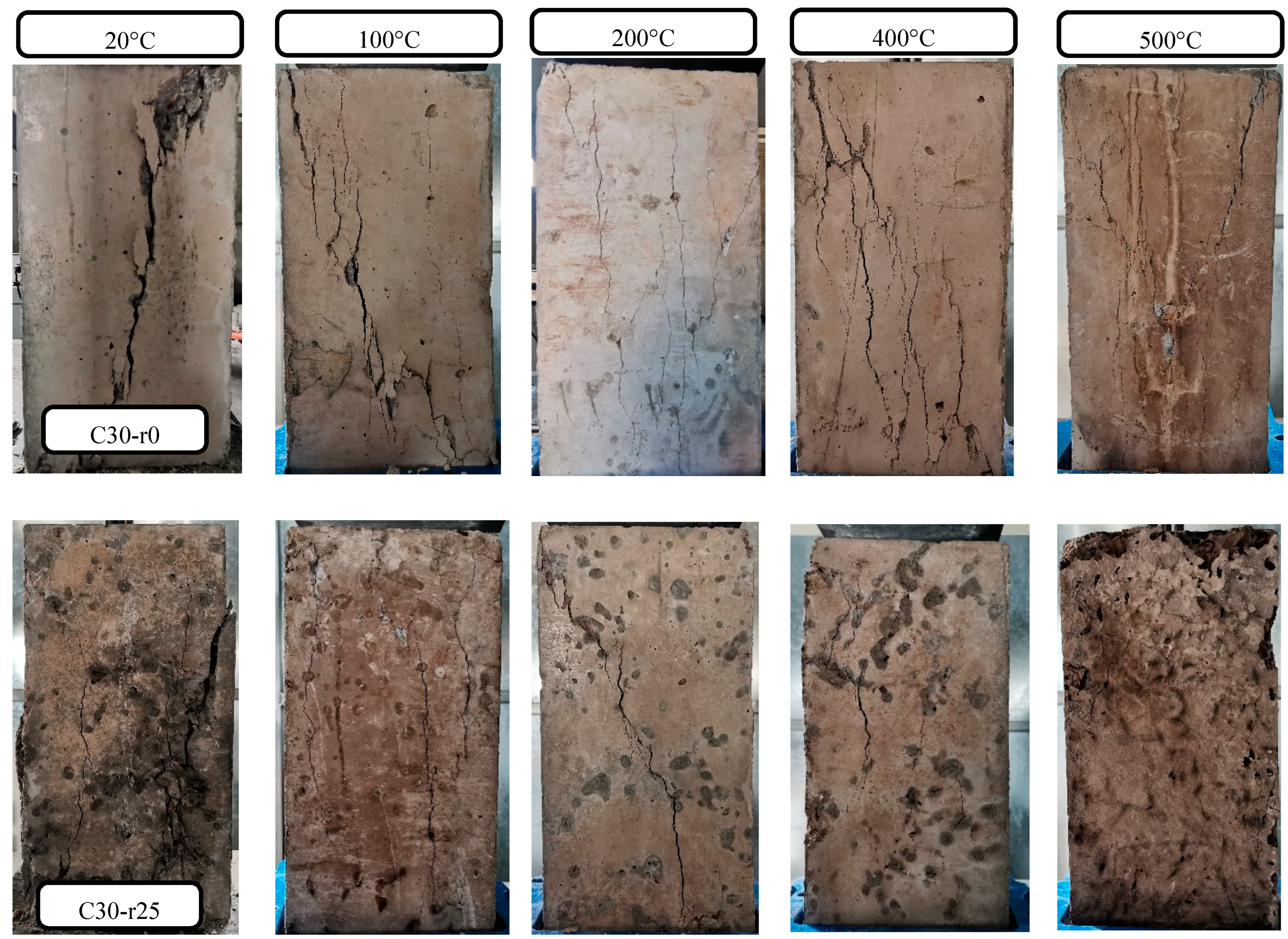
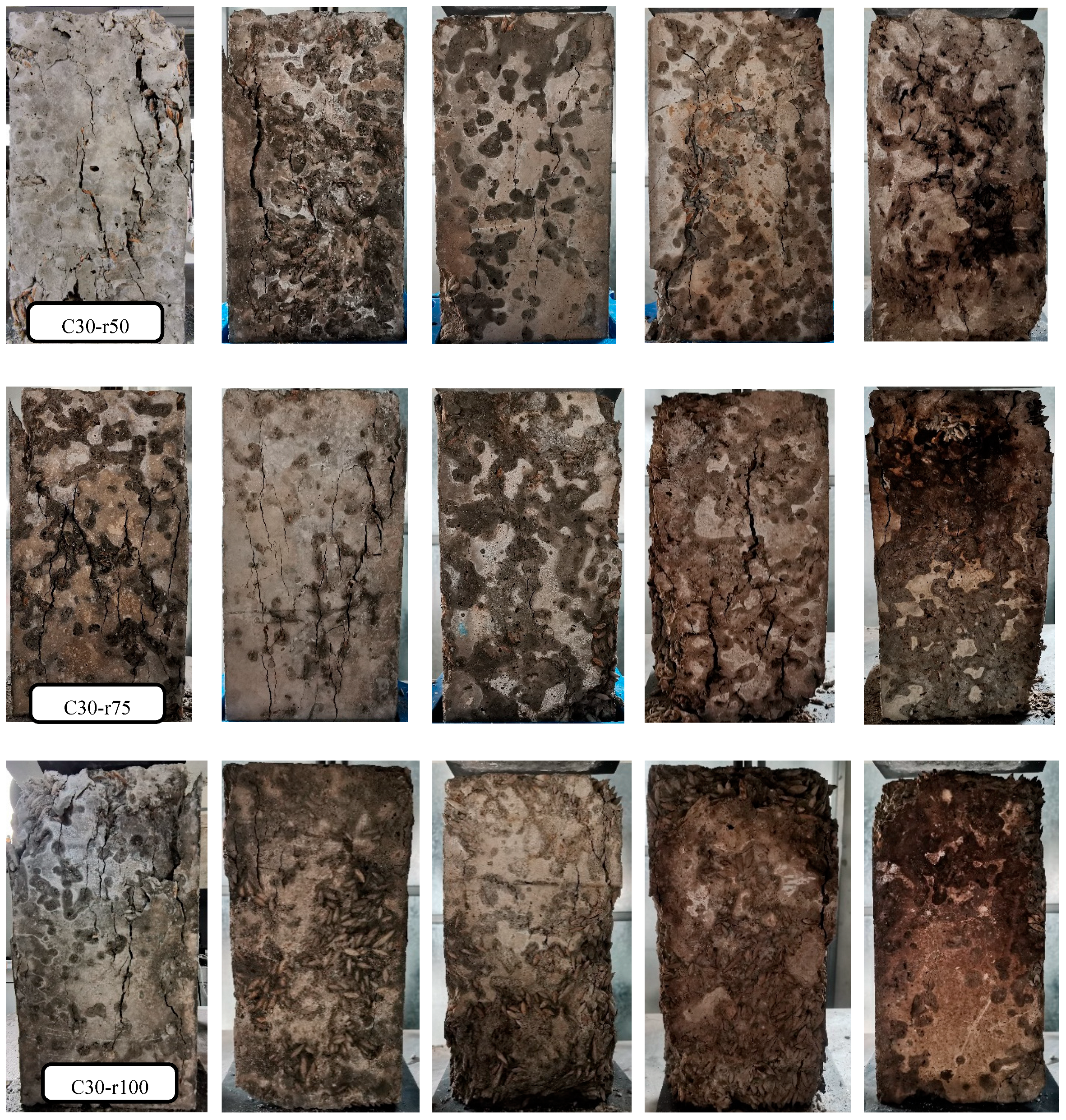
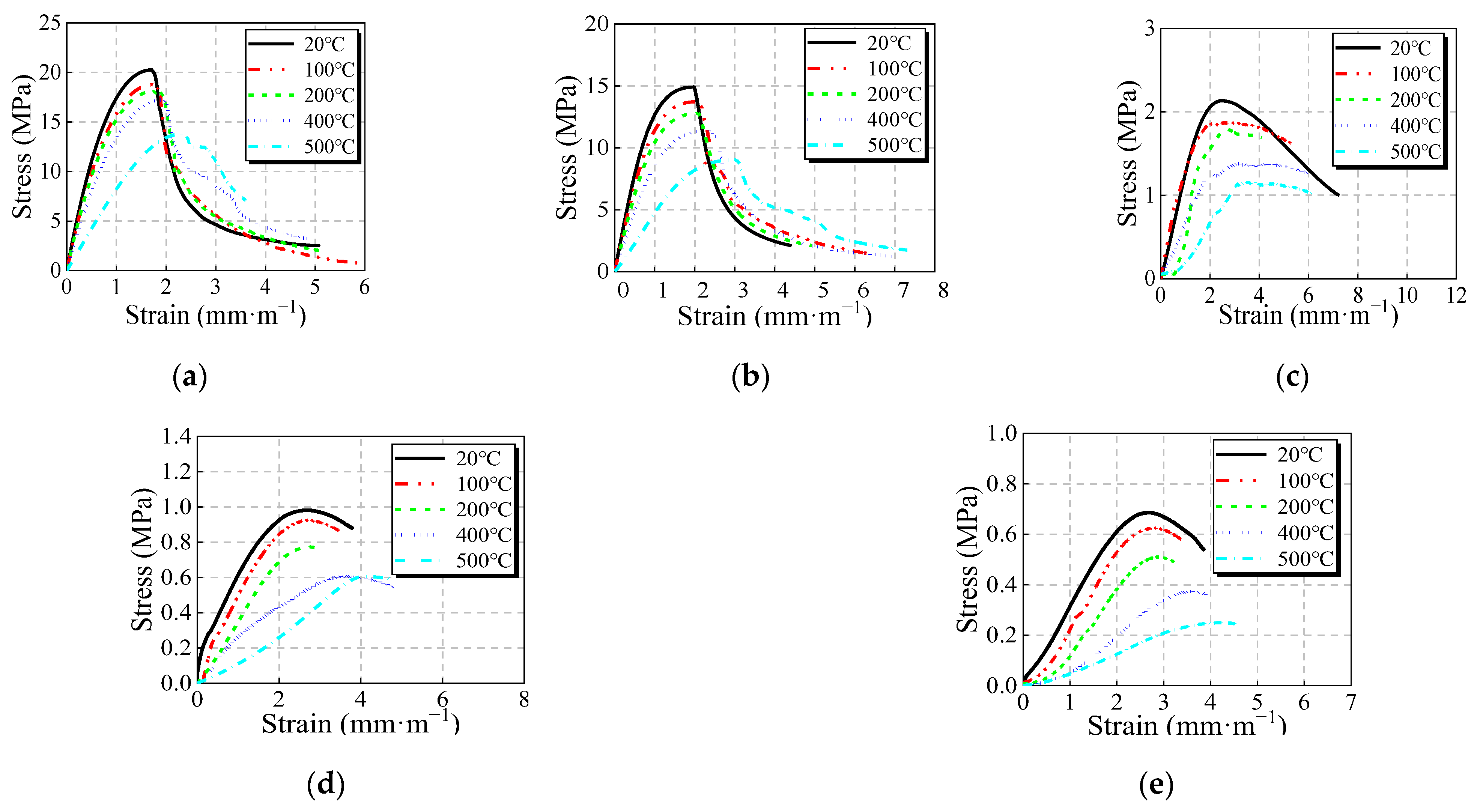

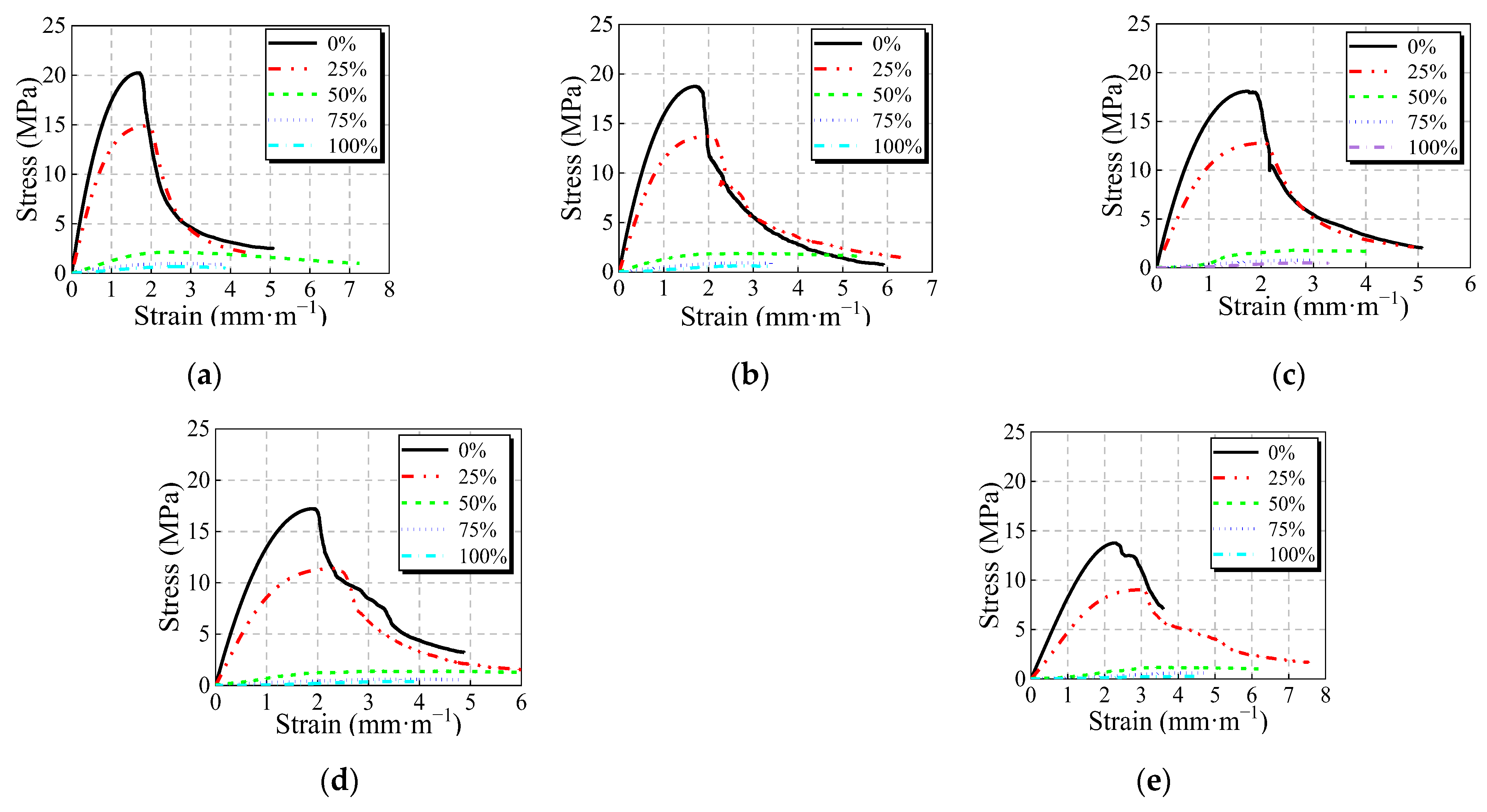

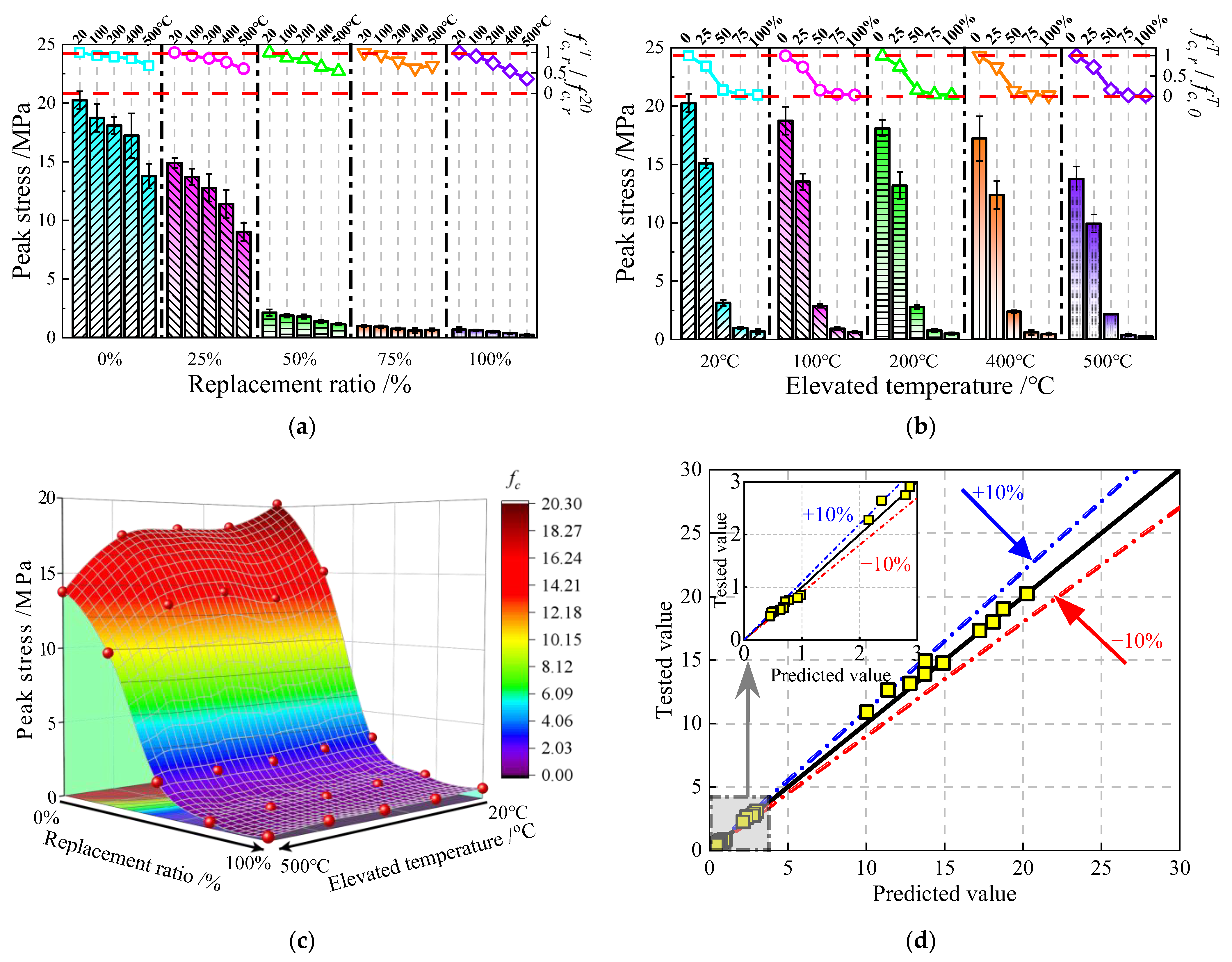
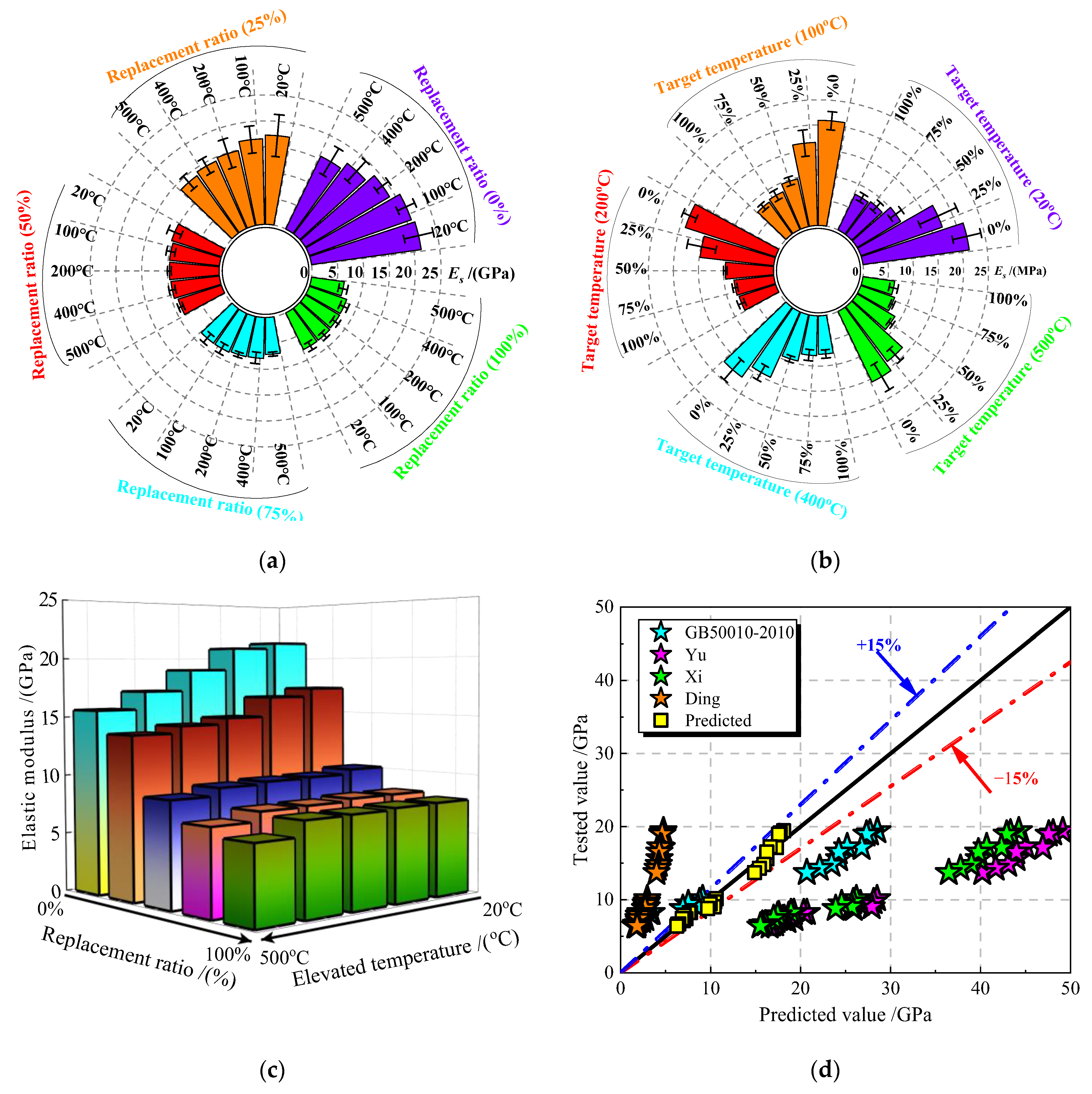
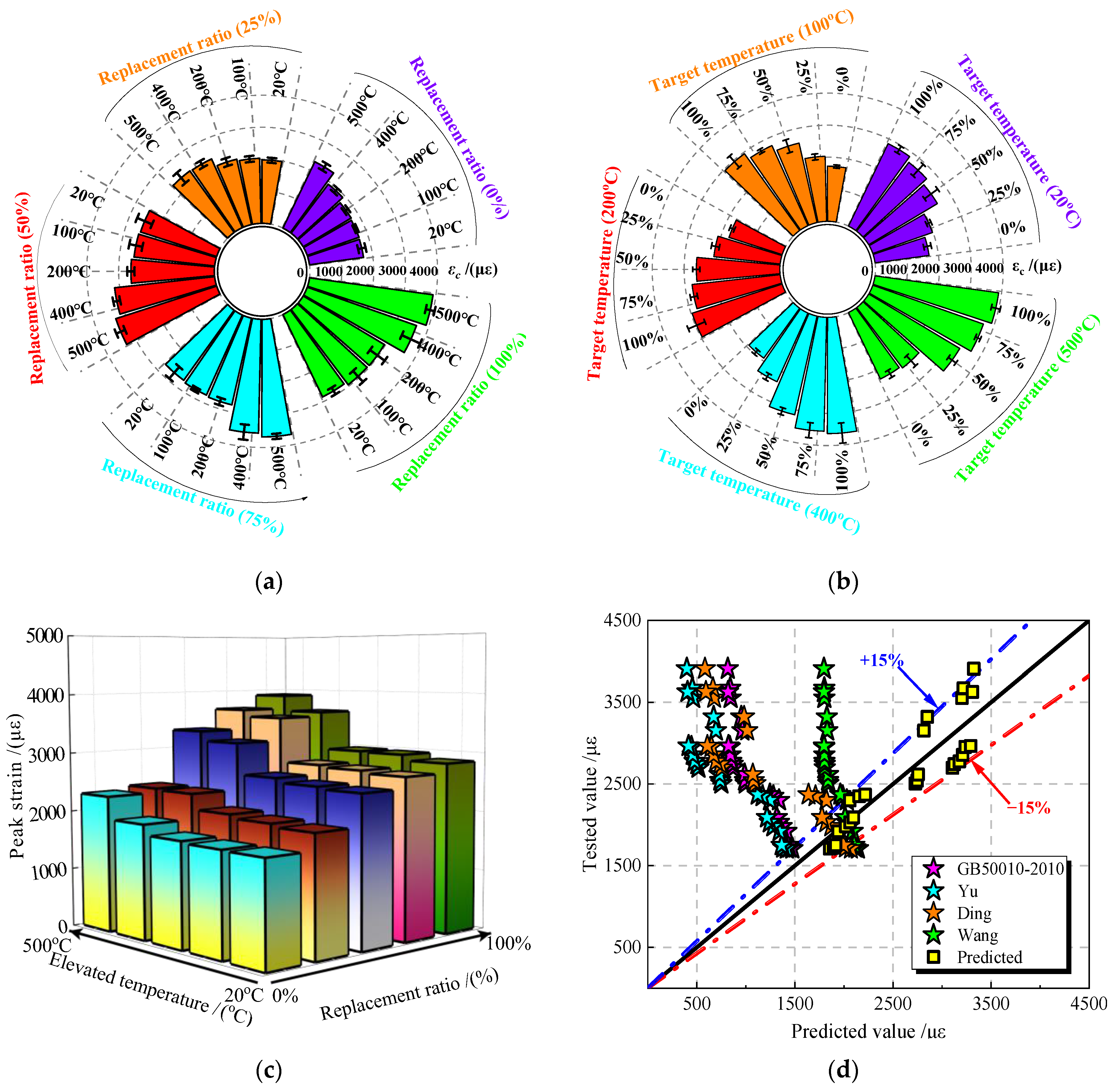
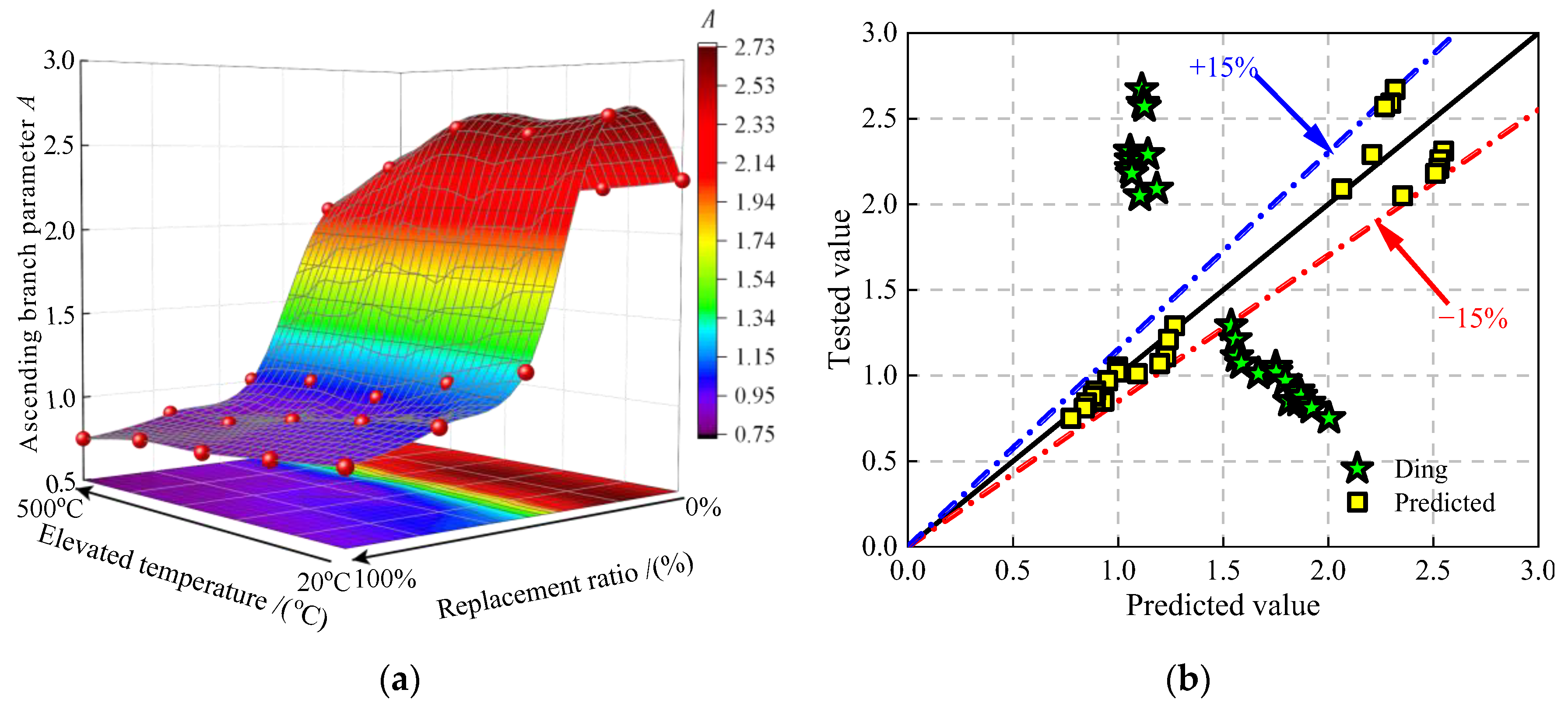
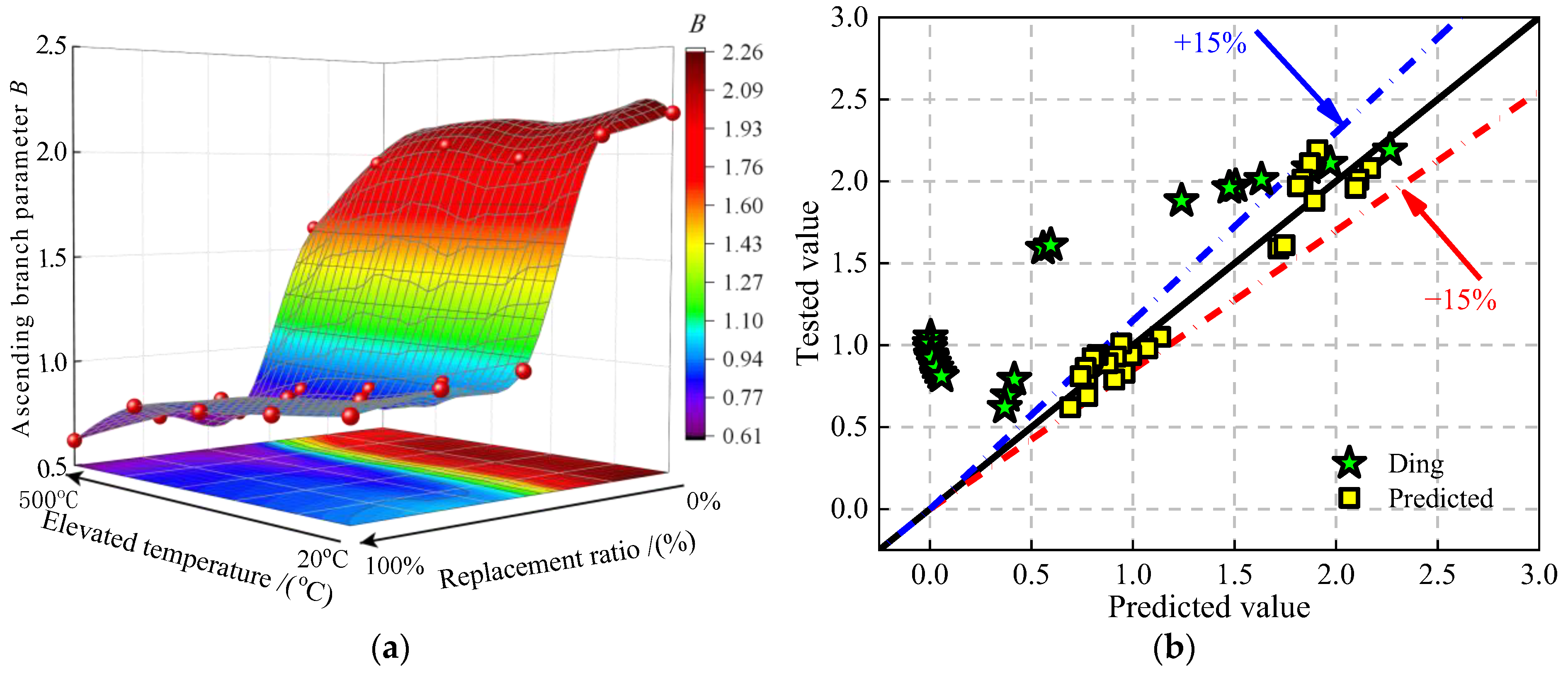

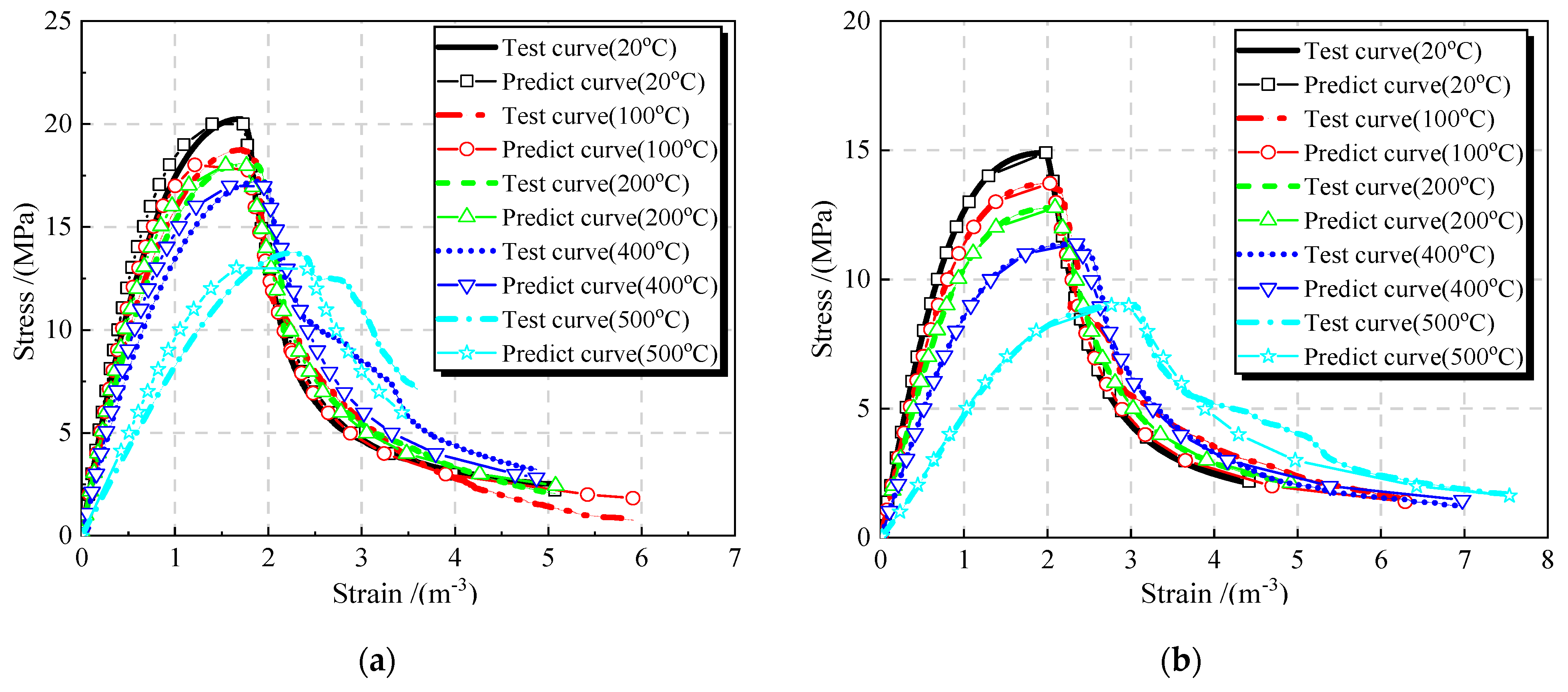

| Gradation/mm | Apparent Density/(kg/m3) | Water Absorption/% | Crushing Index/% | |
|---|---|---|---|---|
| Natural gravel | 5–25 | 2660 | 1.4 | 16.9 |
| Silica sand | 0.25–2.5 | 2580 | 5.6 | 7.8 |
| Gradation (mm) | Apparent Density (kg/m3) | Bulk Density (kg/m3) | Water Absorption (by mass) | Tube Compression Strength (MPa) | |
|---|---|---|---|---|---|
| Big jujube nuclei | 5–31.5 | 1048.56 | 447.50 | 32.50% | 0.52 |
| Small jujube nuclei | 2.36–5 | 1098.63 | 598.50 | 19.50% | 0.92 |
| Mixture Mode *1 | r *2/% | Mixture Proportions /(kg/m3) | |||||
|---|---|---|---|---|---|---|---|
| Cement | Water | Sand | Gravel | Big Jujube Nucleus | Small Jujube Nucleus | ||
| C30-r0 | 0 | 380 | 185 | 648 | 1198 | 0 | 0 |
| C30-r25 | 25 | 380 | 185 | 648 | 898.50 | 18.15 | 102.85 |
| C30-r50 | 50 | 380 | 185 | 648 | 599 | 36.30 | 205.69 |
| C30-r75 | 75 | 380 | 185 | 648 | 299.50 | 54.45 | 308.55 |
| C30-r100 | 100 | 380 | 185 | 648 | 0 | 72.59 | 411.39 |
| r | Temperature | ||||
|---|---|---|---|---|---|
| 20 °C | 100 °C | 200 °C | 400 °C | 500 °C | |
| C30-r0 | P-20-r0 | P-100-r0 | P-200-r0 | P-400-r0 | P-500-r0 |
| C30-r25 | P-20-r25 | P-100-r25 | P-200-r25 | P-400-r25 | P-500-r25 |
| C30-r50 | P-20-r50 | P-100-r50 | P-200-r50 | P-400-r50 | P-500-r50 |
| C30-r75 | P-20-r75 | P-100-r75 | P-200-r75 | P-400-r75 | P-500-r75 |
| C30-r100 | P-20-r100 | P-100-r100 | P-200-r100 | P-400-r100 | P-500-r100 |
| Properties | Number | Ambient | 100 °C | 200 °C | 400 °C | 500 °C |
|---|---|---|---|---|---|---|
| fc (Mpa) | C30-r0 | 20.25 | 18.75 | 18.09 | 17.22 | 13.77 |
| C30-r25 | 15.08 | 13.52 | 13.18 | 12.38 | 10.02 | |
| C30-r50 | 3.01 | 2.87 | 2.79 | 2.38 | 2.16 | |
| C30-r75 | 0.98 | 0.92 | 0.77 | 0.71 | 0.67 | |
| C30-r100 | 0.69 | 0.62 | 0.51 | 0.47 | 0.45 | |
| Ec (GPa) | C30-r0 | 19.43 | 19.11 | 18.96 | 17.13 | 15.61 |
| C30-r25 | 17.24 | 16.52 | 14.83 | 14.30 | 13.70 | |
| C30-r50 | 10.13 | 9.72 | 9.05 | 9.44 | 8.79 | |
| C30-r75 | 8.24 | 8.23 | 7.40 | 7.92 | 7.13 | |
| C30-r100 | 7.87 | 7.42 | 6.69 | 6.64 | 6.39 | |
| εc (με) | C30-r0 | 1708.00 | 1720.00 | 1750.00 | 1920.00 | 2300.00 |
| C30-r25 | 1980.00 | 2030.00 | 2090.00 | 2350.00 | 2370.00 | |
| C30-r50 | 2505.87 | 2542.07 | 2616.47 | 3154.00 | 3321.53 | |
| C30-r75 | 2698.07 | 2742.07 | 2776.73 | 3553.27 | 3672.00 | |
| C30-r100 | 2856.47 | 2952.67 | 2965.33 | 3627.40 | 3909.00 |
| Sort | Parameters | 20 °C | 100 °C | 200 °C | 400 °C | 500 °C |
|---|---|---|---|---|---|---|
| C30-r0 | A | 2.31 | 2.26 | 2.21 | 2.18 | 2.05 |
| B | 2.19 | 2.11 | 2.01 | 1.97 | 1.59 | |
| αc | 8.16 | 8.17 | 7.44 | 7.35 | 6.62 | |
| C30-r25 | A | 2.51 | 2.47 | 2.33 | 2.27 | 2.08 |
| B | 2.08 | 2.01 | 1.96 | 1.88 | 1.61 | |
| αc | 8.39 | 8.41 | 7.51 | 7.42 | 6.76 | |
| C30-r50 | A | 1.29 | 1.21 | 1.11 | 1.07 | 1.01 |
| B | 1.05 | 0.98 | 0.94 | 0.83 | 0.79 | |
| αc | 1.92 | 1.75 | 1.8 | 1.56 | 1.32 | |
| C30-r75 | A | 1.05 | 1.02 | 0.97 | 0.85 | 0.85 |
| B | 1.01 | 0.93 | 0.89 | 0.81 | 0.69 | |
| αc | 0.82 | 0.78 | 0.68 | 0.61 | 0.52 | |
| C30-r100 | A | 0.91 | 0.88 | 0.84 | 0.81 | 0.75 |
| B | 0.94 | 0.92 | 0.86 | 0.81 | 0.62 | |
| αc | 0.62 | 0.6 | 0.41 | 0.40 | 0.20 |
Disclaimer/Publisher’s Note: The statements, opinions and data contained in all publications are solely those of the individual author(s) and contributor(s) and not of MDPI and/or the editor(s). MDPI and/or the editor(s) disclaim responsibility for any injury to people or property resulting from any ideas, methods, instructions or products referred to in the content. |
© 2023 by the authors. Licensee MDPI, Basel, Switzerland. This article is an open access article distributed under the terms and conditions of the Creative Commons Attribution (CC BY) license (https://creativecommons.org/licenses/by/4.0/).
Share and Cite
Li, J.; Jia, M.; Gao, S.; Yuan, J. Uniaxial Compressive Stress–Strain Model of Jujube Nucleus Concrete following Exposure to Elevated Temperatures. Materials 2023, 16, 1037. https://doi.org/10.3390/ma16031037
Li J, Jia M, Gao S, Yuan J. Uniaxial Compressive Stress–Strain Model of Jujube Nucleus Concrete following Exposure to Elevated Temperatures. Materials. 2023; 16(3):1037. https://doi.org/10.3390/ma16031037
Chicago/Turabian StyleLi, Jieqi, Mingming Jia, Shan Gao, and Jian Yuan. 2023. "Uniaxial Compressive Stress–Strain Model of Jujube Nucleus Concrete following Exposure to Elevated Temperatures" Materials 16, no. 3: 1037. https://doi.org/10.3390/ma16031037
APA StyleLi, J., Jia, M., Gao, S., & Yuan, J. (2023). Uniaxial Compressive Stress–Strain Model of Jujube Nucleus Concrete following Exposure to Elevated Temperatures. Materials, 16(3), 1037. https://doi.org/10.3390/ma16031037








